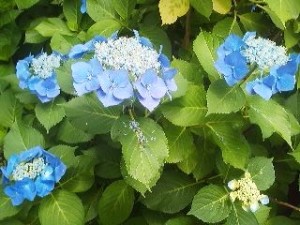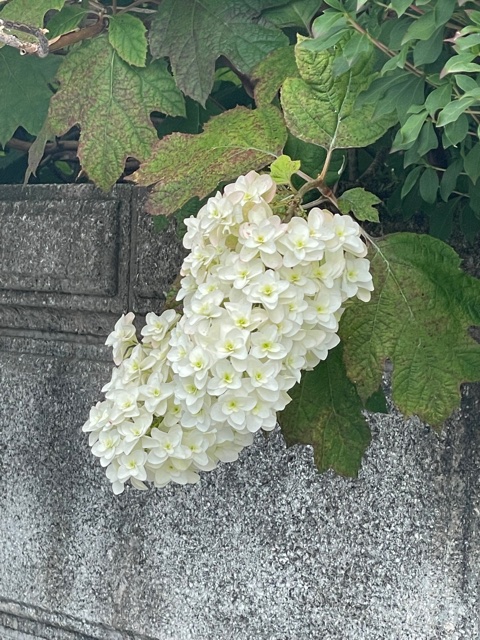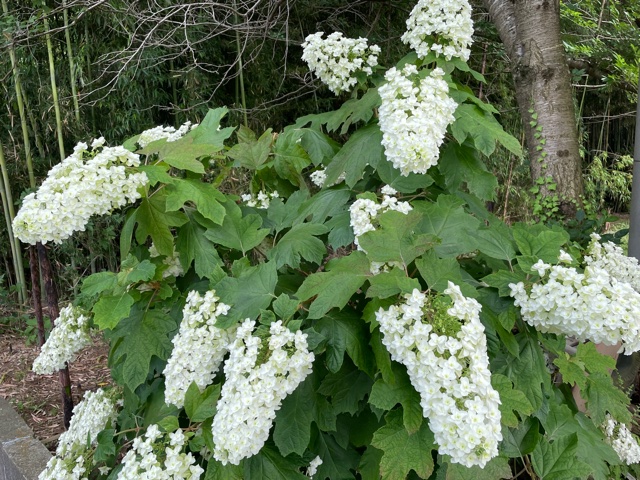
By Avi Landau
Japan’s month long rainy season (tsuyu, 梅雨) usually ends in mid-July, and that means there are precious few weeks left to savor its SPECIAL BEAUTY. Many Japanese consider Ajisai (紫陽花, or hydrangea) to be the quintessential flower of this season, as they look just right when wet, and enshrouded in mist. And though these flowers can be found almost anywhere you turn your head in Tsukuba, thousands of Tsukubans make long trips (or should I say pilgrimages?) to famous ajisai temples, especially in Kamakura. Nearer to home there are 2 other nationally renowned hydrangea-viewing meccas, the Amabiki Kannon near Makabe, and the Taiho Hachiman Shrine in Shimotsuma. Both highly recommended at ANY TIME OF YEAR. All the more so in this season.


The flower has a long history in these islands and many scholars actually assert that it is, in fact, indigenous to Japan and introduced to China from here. After centuries of breeding, numerous varieties have been developed with new colors… pinks and whites, brought out. By taking a look at the etymology of the Japanese name AJISAI, we can see that in earlier times the flowers were mainly blue, as the sounds used to make up the name originally meant a GATHERING OF BLUES (aji-from atsu (集まる) or gather , and ai (藍), indigo blue.

Hydrangea have another Japanese name, however – nanahenge (七変化), or seven transformations, which derives from the flower’s unique characteristic. The colors of the petals change according to the chemical make-up of the soil! This feature has given the flower rich symbolic meaning in Japanese art and poetry — especially to represent a fickle and changing heart*. It is because of this characteristic too, that hydrangea were shunned by the warrior class in the feudal period, because for them, changing colors, or by extension loyalties, was anathema .
* (Here is an example of AJISAI being used symbolically in this sense from the brilliant Nara Period Poet Otomo no Yakamochi. This is poem 773 from Book 4 of the Manyoshu: 言問はぬ木すらあぢさゐ諸弟らが練りのむらとに詐かれけり – KOTOTOWANU / KISURA AJISAI / MOROTORAGA / NERINO MURATO NI / AZAMU KAEKERI – which I translate (or rather explain the meaning) as:
Trees lack the power of speech, but among them is the fickle hydrangea! I believed Moroto’s words, and was walking on air… Alas… I was deceived!)

For Westerners, however, hydrangea can be seen as a symbol of silent devotion, as its scientific name, otaksa, appears to refer to Otaki-San, a woman from Nagasaki’s pleasure quarter, who was the mistress of the German naturalist P.F. von Siebold, who went on to introduce ajisai to Europe .

One more point. These flowers are to be looked at and NOT EATEN. A couple of years ago, there was a nationally reported case of food poisoning which occurred down the road from my house in Tsukuba at the curious and pricey Italian restaurant Toeimon Sakae. The chef, in keeping with the season-conscious aesthetics of Japanese cooking(despite this being an Italian eatery), garnished a dish with the very IN SEASON leaves of hydrangea. These were subsequently consumed by the unsuspecting diners.
This resulted in what must have been an unforgettable scene, right out of Monty Python. You see, the leaves of ajisai have always been used to induce vomiting, especially when poisons were consumed. Imagine then, the eight customers retching uncontrollably, spewing out their expensive dinners onto the antique furniture and tatami mats (this restaurant is in a magnificent thatched roof farm house!).Surprisingly, the penalty for this chef`s oversight was a mere one-day suspension of business.
While you’re out there enjoying the AJISAI DAYS remember: LOOK, BUT DON’T TASTE!




If you`d like to take a special hydrangea viewing trip, you don`t have to go all the way to Kamakura- though that would make for a fine (yet crowded) excursion. The Amabiki Kanon Temple (on Mt. Amabiki just north of Mt. Tsukuba) and the Daiho Hachiman Shrine in Shimotsuma have magnificent Ajisai on their grounds and make for a worthwhile half-day trip in this season.

COMMENTS
- Nora – We can just appreciate a lot of these beautifully fresh AJISAI days,
even with lot of joy to be again since tree weeks in Tsukuba.
Very glad to read you, Avi…
Have a good new week and much of fun with your family! - Mamoru Shimizu – In our garden we have several Ajisai now we are enjoying. Ajisai in Chinese letter “紫陽花”usually we cannot pronounce as Ajisai if we don’t know how to read. We could pronounce SHIYOUKA. 紫=violet,陽=sun, 花=flower , meaning violet sun flower, by this some how we can imagine Ajisai flower. I knew by this Avi-san’s article what the origin of Ajisai word is. Thanks.
Recently young Japanese parent using quite a unique pronunciation method to their children, causing me old-timer often not only have to consider their gender and how to call when be shown names of Chinese letters only. I feel sympathy for teachers of every kind of schools.